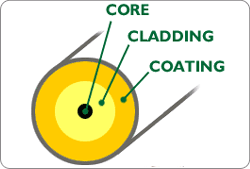| What is the difference between Single Mode and Multi Mode? How do Fiber Optic Cables Work? How are Fiber Optic Cables Made? Read the fiber optic training information below to learn more about the different types of Fiber Optic Cables. Or, for pictures of Fiber Optic Cables, visit our Fiber Optic Cables page. | ||||||
| ||||||
| Once you have your optical fiber core of pure silica, you add an extra layer of glass known as "cladding," which has a lower refractive index than the core. This refractive index difference guides the light in the core allowing as little as possible to leave through the sides (according to Snell's Law). On top of the cladding layer are polymer coatings that make it easier to handle the fiber and help prevent damage to the fiber. | ||||||
| The size of the optical fiber core determines how light travels through it. Each optical signal can actually generate many different lightwaves. These lightwaves can all travel through the fiber at the same time. This is allowed to happen in appropriately named 'multimode' fibers, but can cause problems when each wave arrives at the end of the fiber slightly out of sync. Most modern optical networks will use 'singlemode' fiber, which has a much smaller core than multimode. The core size is small enough to ensure that only one lightwave from each optical signal can travel inside the fiber. This ensures there are no problems at the receiving end. | ||||||
| ||||||
Now that you know some of the basics on fiber cables, we'll have a little more fiber optic training on the two types of fiber optic cables, singlemode and multi-mode fiber | ||||||
| Singlemode fiber A mode is one of the various lightwaves transmitted in an optical fiber. Each optical signal generates many different modes but, in singlemode fiber, the desire is to have only one of them transmitted. This is achieved through having a core with a very small diameter (usually around 10 micrometers). Singlemode fiber has a higher bandwidth than Multimode and, for this reason, it is the ideal transmission medium for many applications | ||||||
| Multimode fiber Multimode fiber is an optical fiber in which more than one mode can be transmitted through the core. A multimode fiber core is much larger in diameter than a singlemode fiber core (usually 6-8 times the size). This larger core size generally has greater bandwidth and is easier to couple and interconnect. It allows hundreds of rays of light to propagate through the same fiber simultaneously. | ||||||
| How Fiber Optic Signals are Transmitted Light that travels along the fiber is made up of a binary code that pulses "off" and "on" and determines what information a signal contains. The advantage of fiber is that these on/off pulses can be almost anything: translated video, computer, or voice data depending on the type of transmitter and receiver used. | ||||||
| Advantages of Fiber Optic Cables Over Copper | ||||||
| Speed: Fiber optic networks can operate at speeds of up to 2.5 gigabits-per-second, versus 1.54 megabits per second for copper | ||||||
| Bandwidth: Taken in bulk, it would take approximately 33 tons of copper cable to transmit the same amount of information handled by 1/4 pound of optical fiber. | ||||||
| Resistance: Fiber optic cables have a greater resistance to electromagnetic noise such as motors, radios, or other nearby cables. Because optical fibers carry beams of light, they are free of electrical interference and noise. | ||||||
| Types of Fiber Cables | ||||||
| ||||||
| Thank you for reading our Fiber Optic Training online information. Should you have any other questions on products, or need ordering information, please do not hesistate to contact us. Our staff is very helpful and knowledgeable, and can walk you through the ordering process to determine what type of fiber optic cable you may need. | ||||||


